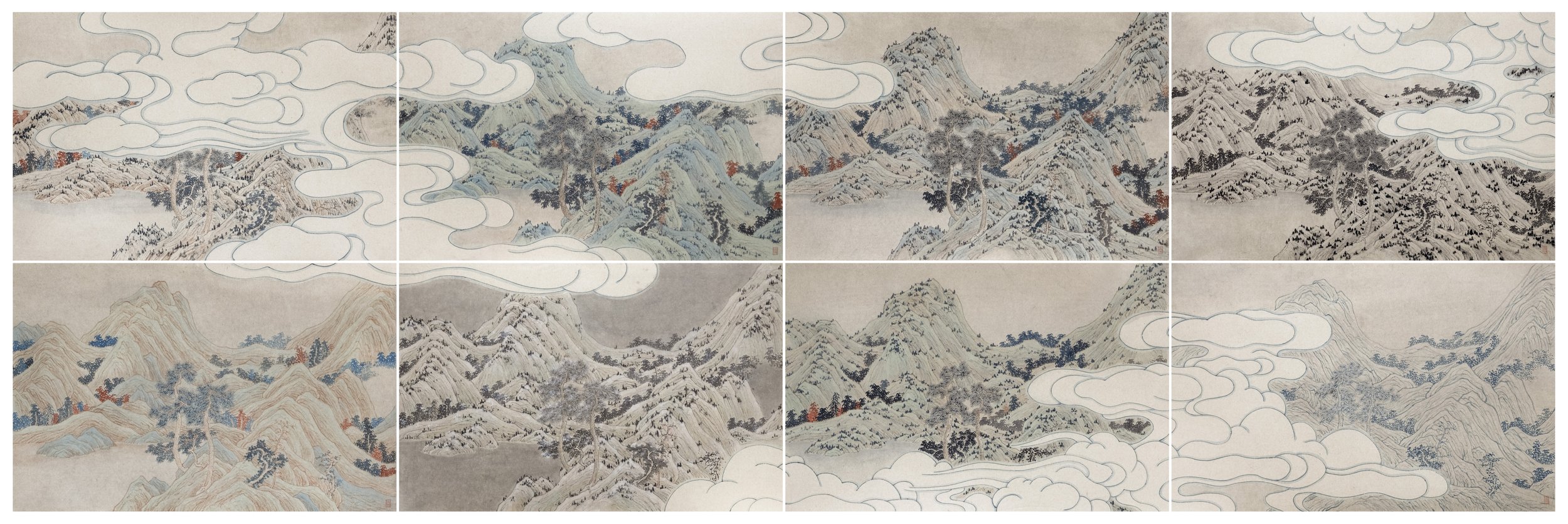YAU Wing-fung
邱榮豐
YAU Wing Fung concentrates on research and creation of "ink art" and focuses on transformation of visual experience, imagination and situationality. His works merge the spatial aesthetics of ink with contemporary visual experience and attempt to expand the spatial imagination of previous ink works. Yau also pays attention to the potential interconnectedness of the contents of the frame, the way of viewing and the external form; therefore, Yau has deliberately adopted three-dimensional or installation formats to construct spatial and temporal scenarios outside of two-dimensional ink.
Yau held solo exhibitions and projects in recent years such as "Illusion" (New York), "Mountains beyond"(Art Central), "All’s well, ends well." (New York), "Looming Sceneries" (Hong Kong) etc. His artworks have also been exhibited in numerous international exhibitions in different countries, such as “Wu Bin: Ten Views of a Lingbi Stone” (Los Angeles County Museum of Art), “Art Basel” (Hong Kong Convention and Exhibition Centre), "Chinese Contemporary Ink" (Christie's Auction), “Ink Asia” (Hong Kong Convention and Exhibition Centre), "Art Taipei" (Taipei World Trade Center) and so on. His artworks have been garnered by Los Angeles County Museum of Art, M+ Hong Kong, public organizations and private collections. Yau graduated from the department of Fine Arts at The Chinese University of Hong Kong. He is currently an assistant professor in the Academy of Visual Arts at Hong Kong Baptist University.
邱榮豐專注於「水墨」的研究和創作,關注視覺經驗、想像與情境的變遷。作品融合水墨的空間美學和當代視覺經驗,試圖擴展前人對水墨的空間想像。邱氏重視畫面內容、觀看方式與外在形式之間的潛在關係。因此,有意利用立體或裝置的形式建構平面水墨以外的時空情景。
邱氏近年曾舉辦《幻真》(紐約)、《山外山》(Art Central)、 "All’s well, ends well."(紐約)、《若境》(香港)等個人展覽;亦多次參與各地展覽,包括《吳彬:十面靈壁圖》(美國洛杉磯郡立美術館)、《巴塞爾藝術展》(香港會議展覽中心)、《中國當代水墨》佳士得拍賣、《水墨藝博》(香港會議展覽中心)、《台北國際藝術博覽會》(台北世界貿易中心展覽大樓)等。邱氏的作品獲洛杉磯郡藝術博物館、香港 M+、公共機構及私人等收藏。邱氏畢業於香港中文大學藝術系,現為香港浸會大學視覺藝術院助理教授。
Selected Solo Exhibitions
Looming Sceneries《若境》- Grotto Central
2019
2015
Roaming Vision in Mirage《蜃遊》- Grotto Central
Selected Joint Exhibitions
2025
2024
2023
2022
2022
Selected Works
Meta 3
-
YAU Wing-fung 邱榮豐
Meta-3
2023
Ink and colour on paper 284 × 92 cm (71 × 46 cm each, a set of 8) -
Repetition is an objective and orderly process. It is not a repeat of the identical image, rather it mutates according to the changing sentiment. Repetition might appear one dimensional, but using the same space with a different outlook generates a totally different depiction. I want to express a subjective viewpoint from an objective depiction.
Within the struggle and contradiction I found my connection to the past, to tradition and the present. The concepts of tradition and contemporary are loaded with preconceptions and prejudice. They do not simply mean old or new, obsolete or popular. They are both an ever mutating process. Artist and audience together create a cultural ideology that transcends time and space. The “Meta” series is both a collective and individual expression. It can also be deemed an infinite expansion. By traversing different pictorial space I found my desired connection. At the end of one I encounter a new opening, leading me to another space.
重複性是帶著客觀和規律的過程。但於我看來,這並不意指不變,而是在不斷重塑的過程中,觀察著自身的感受變化。過程看似單向,但在相同的空間中創造不同,這種轉換超越了單純地描寫空間的意義。隨著熟練程度的掌控,更能從客觀的本體中產生主觀的感受,當中的掙扎與矛盾把我連結到過去、傳統或當下的錯亂時空之中。
傳統或當代是一種帶有前設或偏頗的想法。它並非意味 著過去與新舊,而是一種持續進行的態度。傳遞者與受眾同時創造著一種文化意識及形態,這往往超越了時間與空間的限制。就如”Meta-”系列的作品,既是整體又是獨立,甚或是無限的擴展, 我們不斷在往返的時空中找尋某種連結, 在結束與過去之間聯繫另一個開端。
Looming Scenery III
-
YAU Wing -fung 邱榮豐
Looming Scenery III 若境 03
2019
Ink and color on paper
136 × 59 cm -
"Viewing" Sceneries
The spatial expression has been emphasized in Chinese landscape painting (shan shui hua). The spatial relationship of the object is “constructed” through the painter’s ingenuity. The concept of “space” (the word “space” originates from western, which is a philosophy proposition with multi-meaning.)refers to “world view” (yu zhou guan) in China. “yu” represents space and “zhou” represents “time”. Therefore, the concept of “time and space” is essentially imprinted on the spatial expression of Chinese landscape painting. “Viewing the small from the big” (yi da guan xiao) is the method to express the relationship between time and space in ancient landscape painting. It is a reflection of psychological consciousness of the painter who faces the objective scenery. The development of my artworks have been accompanied by the concept of “view” (guan) which refers to the expression of spatial imagination through the “observation”. It is also a psychological process of integrating my imagery and imagination, which is different from “seeing” - a reflection of objective vision - reconstructing realism. On the other hand, I treat “view” as a way of viewing. Some source materials like aerial images, photography and satellite images provide various ways to obtain comprehensive vision nowadays. I have also tried to borrow from the remote-sensing images as the visual vocabulary in my painting. Intellectual and logical ways are definitely not the principal to depict the spiritual world in landscape painting. However, the spatial expression of subject spirit and imagery can be manifested through the integration between nature and human, including all subjective consciousness, aesthetic of form as well as the depicted object by the painter. As Wang Wei (c. 415-453), “Paintings” said: “it is limited to appreciate the landscape by only using the eyes. The mind should be released from the narrow sight and the eyes, and imagine the scenery inside the mind.”
In short, “view” is the reflection of my psychological consciousness and feeling when I am facing the object. “Far” is the intention of my spirit when I am depicting the object. The concept of both “view” and “far” reflect the expression of space in the artworks. “Transition Scene” as a proposition among “view” and “far” means that changing situation to express the changing scene in various situations. “Transition” refers to the changing and moving time. “Scene” involves the reflection of mental consciousness and space. The depiction of space-time relationship will be shown in my two-dimension or three-dimension artworks by integrating the compositions and the angle of the object. Trying to create out of the boundary of previous landscape paintings and constructing the visual “patterns” in spatial aesthetic of ink, experience the different notions and concepts between form, spatial and temporal dimension, moreover, to explore the potential relationship between the “viewing” methods, content and external form.中國山水畫一直講究空間表現,並透過畫家匠心「經營」對象的空間關係。中國的「空間」概念即是「宇宙觀」(「空間」一詞本源於西方,屬多義的哲學命題)-「宇」代表著空間,「宙」代表著時間,因此,「時空」的概念本質上烙印於中國山水畫的空間表現之上。古代畫家透過「以大觀小」的統攝之法來表現山水的時空關係,呈現出來是畫家面對客觀景物時心理意識的反映。我的創作圍繞著「觀」的概念發展,當中的「觀」指透過觀察表達對山水的空間想像,是一個整合意象和想象的心理過程,與「看」-客觀視覺的反射-寫實再現-有所區別。另一方面,我亦視「觀」如觀景的方式。現代能透過鳥瞰角度、攝影以至衛星影像等方式獲得更全面的視野(如我有意鑑遙感圖像作為畫面的「圖式」元素),為「經營位置」提供更多維度的空間想像。當然,山水畫的精神並非以知性思維與邏輯性的方式來看待自然世界,而是通過山水與人的交契合一,包括一切主觀感受、形式美感以至描繪對象的結構表現等,彰顯人的主體精神及意象化的空間表現。正如王微(415-453)《敘畫》所言:「目有所極,故所見不周。於是乎以一管之筆,擬太虛之體;以判軀之狀,盡寸眸之明。」
概捨而言,「觀」是我面對對象時呈現的心理意識及感受;「遠」是我描繪對象時的精神指向,兩者均體現在作品的空間表現之上。在「觀」和「遠」的意義下,我以「渡景」作為命題,表達不同語境下的視覺經驗及情景變遷。「渡」意謂過渡、變遷,蘊含時間的遷移,呈現個人的心理意識;「景」即景色、情境,是空間意識的反映。作品透過平面或三維的空間配置,結合畫面佈局,描寫對象的時空關係,試圖從前人對山水畫的視覺經驗中脫邁出來,把視覺「圖式」及觀念置陳於水墨的空間美學之上,期望體現對時間、空間與形式的不同概念,以及探討觀看方式、畫面內容與外在形式的潛在關係。








